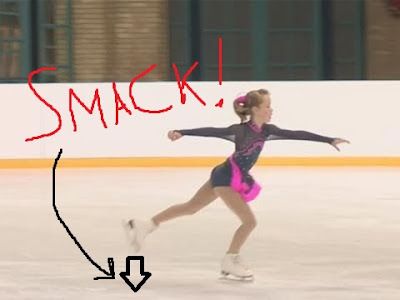Skating 101 - Jumping, An Intro, Some History and The Basics
I'm shortly going to be writing a series of posts describing the six free skating jumps that are used in free skating. These descriptions will be via the medium of absurdly silly "real life" situation comparisons that will hopefully at least give you a laugh even if you don't learn anything about the jump executions.
Before that though, we need to talk a bit about the general bits and bobs of jumping on ice. This will no doubt be nothing new for regular skaters, but I write for family and friends as well and they appreciate the explanations where I remember to do them.
First up, there are the "toe" jumps:
Before that though, we need to talk a bit about the general bits and bobs of jumping on ice. This will no doubt be nothing new for regular skaters, but I write for family and friends as well and they appreciate the explanations where I remember to do them.
A bit of history
Most of the standard jumps that are used in competitive skating today were invented between 1880 and 1930 (though it's not entirely clear exactly when for some), but why do we jump on the ice at all? Honestly, I thought about researching this to get to the origins of jumping in ice skating, but I strongly suspect that the actual answer boils down to "because we can." Humanity's nature of experimentation and pushing our limits meant that jumping on ice was probably inevitable at some point. The idea's pretty silly when you think about it, we don't even jump that much on land, but given that ice skating is somewhat similar to gymnastics then it probably shouldn't be all that surprising that we adapted those athletic ideas onto the ice. Regardless, the fact of the matter is that jumps in free skating are one of the main programme components and they appear to be here to stay.The basics
There're three general commandments of jumping in skating, which are:- Thou shalt take off and land backwards
- Thou shalt use the correct foot and blade edge for the jump you're attempting
- Thou shalt make the correct number of revolutions in the air - one for a single jump (360° ideally, just so we're clear), two for a double, and so on
The idea of taking off backwards probably sounds rather alarming, but this is largely about safety and practicality than anything else. When landing, you want to be landing backwards as you'll typically catch your landing on the toe pick of your landing leg and roll your weight down from that point along the blade. Free skating blades have more length at the back to let you absorb the landing momentum through them, and the boot itself has the most support in the heel and ankle part, so you're at your most stable when skating backwards. So, if you're landing backwards and you have to do a full revolution then it makes sense that you also start the take off going backwards - it all sounds insane but you get used to it pretty quickly.
Of course, there're exceptions to these commandments, most notably the Axel breaks both the taking off backwards and number of rotations rules, but I'll cover those in its own article.
The jumps
There're six commonly used jumps in total, most of which all look much the same from a non-skater's perspective, and the reason for this is that once a skater leaves the ice and starts rotating then the distinction between the jumps because basically impossible to see from an observer's perspective. The distinction between each jump is based almost entirely on the method of entry used going into the jump. Conveniently, the entry methods, or jump types, helpfully divide down into two categories that we can get into now.- Toe loop
- Flip
- Lutz
The toe jumps are characterised by the fact that to take off into the jump you have to plant the toe pick of your non-skating foot into the ice behind you to give you a launching point to jump from. I use the word "plant" but it's probably more accurate to say it often looks like people smack their toe picks into the ice as they spring upwards.
 |
| This skater's soon to be smacking her left toe pick into the ice to perform the toe loop |
And, for the second group of jumps, there are the "edge" jumps:
- Salchow
- Loop
- Axel
Anyone with a casual interest in ice skating may well recognise the Salchow and Axel names as they're probably the most well-known. The edge jumps are characterised as jumps whereby you theoretically generate your lift through aggressive knee bend of the skating leg and by allowing your momentum to curve off one of the edges of your blade. This is honestly quite hard to imagine, but if you think of your backwards skating momentum as primarily being focused in the heel of your skating blade and you then transfer your weight and that momentum further up the blade until it reaches the toe pick of the blade you're skating on. At that point, the momentum stops at the bottom-most toe pick, which gives you a similar kind of stopping point (as in the toe jumps) to allow the momentum that's travelled along the blade edge to be directed into the ice and give you lift.
That's enough to get us started in this series, I'll be doing another intro post for this series next to discuss how the jumps are considered difficult before I move on to detailing each jump.
Happy skating!
Happy skating!

Comments
Post a Comment